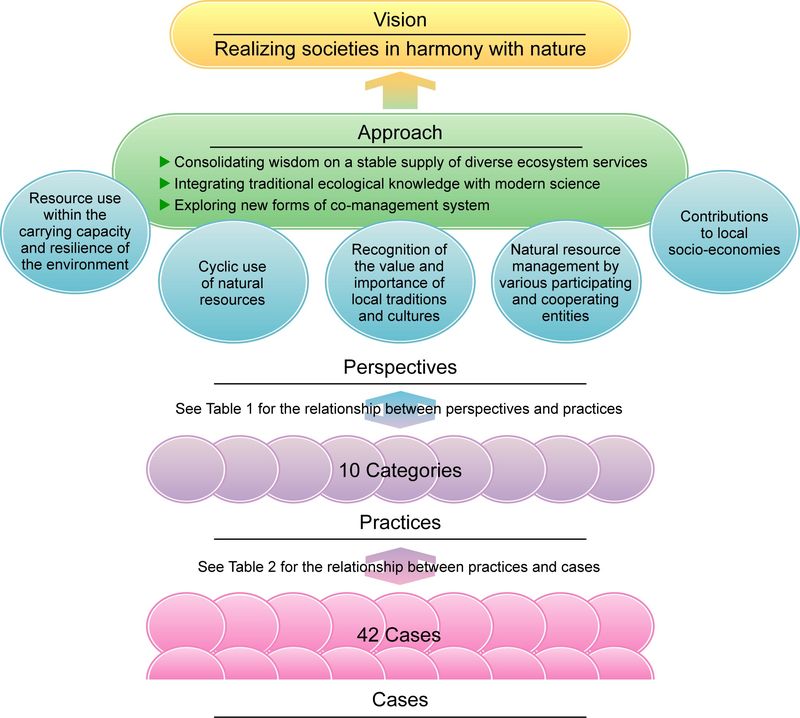Practices for the sustainable use and management of natural resources
As part of the activities of the Satoyama Initiative, whose aim is to realize societies in harmony with nature, the Ministry of the Environment of Japan has categorized and put together practices for sustainable management of natural resources and related cases that have the potential to contribute to the maintenance and rebuilding of socio-ecological production landscapes.
This document also serves to provide an idea of the activities of "collecting, analyzing, and deriving lessons from cases and promoting the dissemination of information related to technology", which form part of the proposed activities of the International Partnership for the Satoyama Initiative. However, the categories for the practices in the following table are not definite, and assumed to be added or revised depending on future research.
(The practices and their relevance to the perspectives of the Satoyama Initiative)
The practices were categorized in the context of their relevance to the five perspectives of the Satoyama Initiative .

Fig1. Structural image of information shown on this page
1. Structuring of practices and their relevance to the "five perspectives" of the Satoyama Initiative
Practices are classified into ten categories. Each category relates to the "five perspectives" of the Satoyama Initiative as follows:
Table 1: List of practices
| Categories | Relevancy with the five perspectives of the Satoyama Initiative (O: Highly relevant, o: Relevant) |
|||||
| Resource use within the carrying capacity and resilience of the environment | Cyclic use of natural resources | Recognition of the value and importance of local traditions and cultures | Natural resource management by various participating and cooperating entities | Contributions to local socio-economies | ||
| Category 1 |
Securing a functional resource-circulation system through the introduction of compound, multilayered land use [PDF 62KB] (agroforestry, home garden, mosaic land use etc.) |
O | O | O | o | o |
| Category 2 |
Introduction of agriculture, forestry and fishery with consideration for the conservation of biological and ecological functions [PDF 63KB] (permaculture, organic farming, low-input farming, ecosystem-friendly farming and forestry, resource controlling fishery etc.) |
O | O | O | o | o |
| Category 3 |
Effective utilization of multidimensional functions of ecosystem services using vegetation [PDF 70KB] (bioshield, forest-conservation-based erosion control etc.) |
O | o | o | O | O |
| Category 4 |
Development of local industries and local revitalization using traditional culture and technologies [PDF 58KB] (community business, handicraft, development of local specialties etc.) |
O | o | O | o | O |
| Category 5 |
Biomass utilization within the carrying capacity of local natural resources [PDF 81KB] (utilization of biomass energy and biomass materials) |
O | O | o | o | O |
| Category 6 |
Mechanisms of joint forest management and use and profit sharing among participants [PDF 70KB] (community forestry, social forestry, residential forestry etc.) |
O | o | o | O | O |
| Category 7 |
Channeling of the profits from cultural ecosystem services into natural resources management [PDF 55KB] (eco tourism, green tourism, agri-tourism etc.) |
O | o | o | O | O |
| Category 8 |
Promotion of agriculture and conservation of farmland by linking farmers and consumers [PDF 51KB] (CSA, community food system, box scheme, local production for local consumption, cooperation between producers and consumers etc.) |
O | o | o | o | O |
| Category 9 |
Conservation and management of upstream forests by fishermen and water users [PDF 71KB] (watershed management, upstream and downstream cooperation etc.) |
O | O | o | O | O |
| Category 10 |
The mechanism of incorporating corporate social responsibility toward biodiversity into sustainable management of natural resources [PDF 67KB] (biodiversity offset, mitigation banking, environmental labeling and mechanism of fund raising linked with CSR activities etc.) |
O | o | o | O | O |
2. List of cases and their relevance to the practices
Forty-two cases are introduced in table 2 (among these, 15 are in Japan and 27 are around the world).
Each case relates to the practices as follows:
Table 2: List of cases
Note:Information shown above contains the results of projects carried out by the Ministry of the Environment of Japan as well as research conducted by the United Nations University Institute of Advanced Studies (UNU-IAS) with the support from the Ministry of the Environment of Japan.The projects of the Ministry of the Environment of Japan were assigned to and undertaken by Japan Wildlife Research Center and PREC Institute Inc.